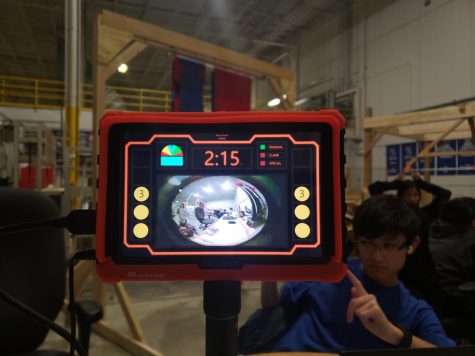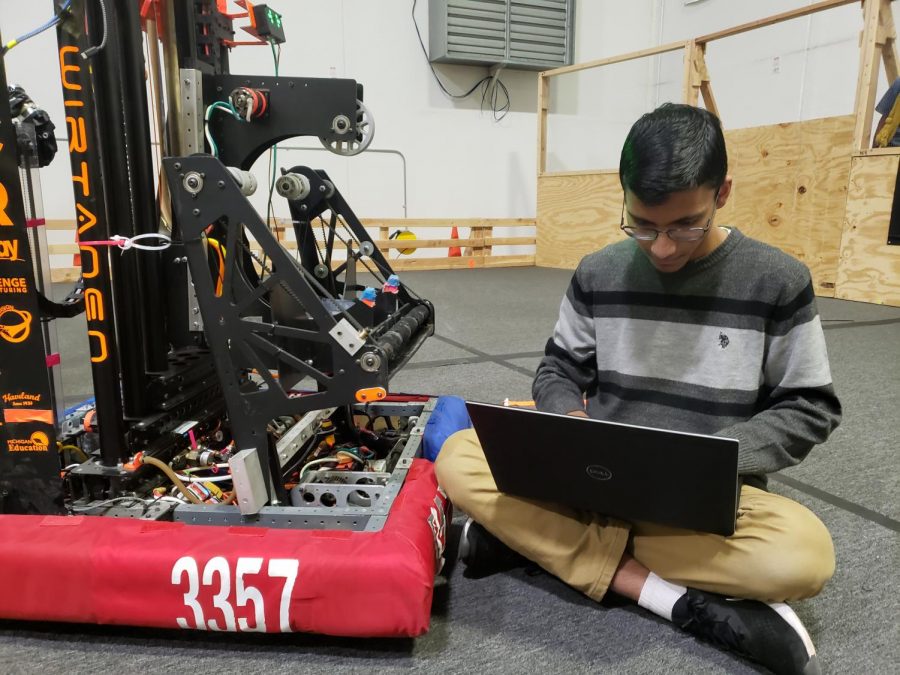Sahil Sawant uses his robotic skills in hopes of idealizing the future

More stories from Olivia Luplow
Sophomore Sahil Sawant is a natural inventor. When in need of something new, Sahil’s first instinct isn’t centered upon purchase; he opts to find a different solution.
After his brother took the family’s 3D printer with him to college, Sahil was, sadly, printerless. For his rigorous course load stuffed with STEM classes, such a tool is a must. His solution, then, was simply to build his own.
“With the things that I do, it’s kind of helpful to have [a 3D printer],” Sahil said. “Right now, in chemistry, we’re making soap. If I wanted it to be in the shape of a square, then I could 3D print a mold for it. But I don’t have a 3D printer, so I can’t really do that. They’re useful for pretty much anything; I’ve thought about buying them, but they’re really expensive. But, if you make one from scratch, which is actually not that hard, then it’s way cheaper.”
Sahil’s interest in science is much broader than the creation of a printer, though. With one hand deep into the STEM program at FHN and the other delving into extracurriculars such as Science Olympiad and, most passionately, the robotics team.
First inspired by his brother, Sahil says that he had always been interested in the team, but after being given that extra push, he decided to “just go for it.”
“I’d probably have to say my brother [is my biggest inspiration for joining robotics],” Sahil said. “He was kind of the guinea pig for my family. He did all of these things; he was in the first class of STEM when it just came out four years ago.”
Now a member of the team, Sahil states that the team atmosphere is his favorite aspect of robotics, other than the math and science behind their creations, of course. As a combined effort between all three Forest Hills schools, the thirty other students who he chooses to work with every day have all become important to one another, he says.
“We’re all really close,” Sahil said. “We all have similar thoughts and feelings about engineering. We all want to do something related to STEM when we grow up, so it’s just kind of nice being around those kinds of people.”
Sahil’s position as a programmer plays a vital role in the team’s success as he uses his wits and vigorous drive to create the controls for their robots. This year, with their task being to shoot balls into a basketball-like hoop, he is working to create a driver’s station for the robot and takes great pride in making sure that everything runs smoothly.

In terms of what he will take with him after high school, Sahil hasn’t quite thought that far just yet. Although he knows that something relating to business or engineering, such as a mechanical or software engineer, would be his first choice, his decision remains unclear.
“Robotics gives me firsthand experience,” Sahil said. “Now I have experience with programming actual industrial things and [with] mechanical engineering. It’s also good for college applications; it’s something good on your record.”
When he’s not working on building his own 3D printer or programming a control system for a robot, Sahil takes on another hobby: tennis. Once again gaining inspiration from the members of his family, he states that his long-standing ping pong background led him to the tennis team.
“I’m a huge ping pong player; I play a lot with my dad,” Sahil said. “[I thought] I might as well play tennis as my high school sport if I’m already good at ping pong. It’s not the same, [though]. You have to run around [in tennis]; it’s not just a table that you’re around. I don’t have really good stamina, so sometimes, it’s a little tough.”
Whether it be in the robotics or tennis team, Sahil has an innate grasp for teamwork. Both situations, he says, require an immense team effort, and it is no stretch to say that Sahil is a team player.
“Similarity wise, [both tennis and robotics] are a team effort,” Sahil said. “If we’re playing tennis, [everything depends on] how many wins your entire team has. It’s the same thing in robotics. In robotics, you have different groups: CAD, programming, electrical, mechanical, and machining. All of them do different parts, but if one of them doesn’t do their job, then we can’t have the robot. It’s impossible. You need all of those groups and without them, there’s just no chance of having a robot or winning at all.”
Although these group aspects stand to influence Sahil in his current efforts, he looks towards one specific, and very famous, individual for inspiration in his future endeavors.
“Elon Musk would also probably be a huge [inspirational] figure just because, ever since he was a kid, he used to have all [of] these crazy ideas, and he’s actually like making them come true,” Sahil said. “[Ideas like] going to Mars and making an all-electric car, like Tesla. He has six different companies. He has all of these dreams, but rather than just dreaming about [them], he actually works to achieve them.”
Even as Sahil works to achieve his current dreams, he is looking ahead to something bigger. In the future, he hopes to use his background in STEM and robotic experience to create something even greater than himself.
“I definitely haven’t thought of anything yet,” Sahil said, “but if I can, in the future, [I’d like to] make something that could help improve the world or just overall living standards. [I want to make] something that could help the world. That would probably be something I would do or at least try to do.”

Olivia Luplow is a senior and is entering her second year on The Central Trend as a staff writer. This year, she has taken over the position of Public...



























































































